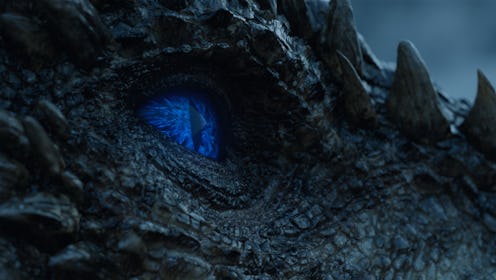Entertainment
This Ice Dragon Fact Could Change The Way 'Game Of Thrones' Operates For Good
If you are a Game of Thrones fan, you are probably still trying to collect yourself after what went down in GoT Season 6's penultimate episode Sunday night. The latest heartbreaking death in the GOT family came (spoiler alert!) when the dragon Viserion was taken down by the Night King with an icy spear to the heart. Later, he was brought back to life as a wight by the Night King, and the internet rejoiced in the confirmation of a long-standing GoT fan-theory: that ice dragons exist. Yet even though the show has once and for all verified their existence, there are still many questions surrounding the chilly beasts. How many of them will there be? Can fire kill them? And most importantly for the purpose of the show, do ice dragons breathe ice?
The Night King's new deadly pet is sure to cause trouble for the living in the upcoming war, but because Viserion's existence as this creature is still so new (his icy form got just about three seconds of screen time) there is still much we don't know. The most comprehensive, first hand description of the animal comes from George R. R. Martin's World of Ice and Fire book which describes ice dragons as:
"Colossal beasts...said to be made of living ice, with eyes of pale blue crystal and vast translucent wings through which the moon and stars can be glimpsed as they wheel across the sky. Whereas common dragons (if any dragon can truly be said to be common) breathe flame, ice dragons supposedly breathe cold, a chill so terrible that it can freeze a man solid in half a heartbeat."
It obviously makes sense for ice dragons to breathe ice, and this description seems to confirm that. However, there are some red flags in the description that highlight some potential differences between the book version of ice dragons and the ones fans have seen on-screen. For example, Viserion is not "made of living ice." At the end of the episode, the only thing that seemed to be different about him is his eye color, not his whole anatomy. Also, the phrase "colossal beast" seems very vague and up to interpretation — are these creatures supposed to bigger than normal dragons, or can the word "colossal" be used to describe common dragons as well?
Ice dragons appear very sparingly in the Game of Thrones universe but they are referenced much more in the books than on the show, so it is entirely possible that the dragons we see on-screen are very different than the ones in Martin's mind. The book description seems to focus more on the theory that the ice dragons are created from ice, not from a dead dragon as happened on the show.
The writers of Game of Thrones treat the show's plot like a mythological hydra in that they answer one question, but then 10 more pop up in its place. Viewers may now know that ice dragons exist, but so much is still up in the air in regards to how they operate, their inevitable effects on the war to come (which are bound to be huge), and so much more. Sadly, we just have one more episode to go before the long night (AKA the year in between GoT seasons) begins, so while it is possible that some of these questions may get answered, it is more likely that we'll be left with plenty of mysteries over the coming months.
